Mental handicap
In 1847 Mrs Ann Serena Plumbe was dismayed at the difficulties faced by her mentally handicapped son, Andrew Reed Plumbe, and in the plight of such children in Whitechapel where they lived. She wrote over 600 letters to individuals (including Dr John Connolly, the Medical Superintendent of the Middlesex Asylum in Hanwell) who might be interested in the establishment of an institution where training and education could be provided for these children. She approached Revd Dr Andrew Reed (1787-1862), the minister at the Wycliffe Chapel on Philpot Street, with which the Plumbes were associated. Reed, a well-known philanthropist, had been involved in various charitable foundations - the London Orphan Asylum, the Infant Orphan Asylum, the Asylum for Fatherless Children and the Royal Hospital for Incurables. He had himself been thinking about such a venture, and agreed to help if Mrs Plumbe could find six idiot children within six days. She returned, having found 28, most of them living in a wretched state.
Dr Reed called a meeting to discuss the matter on 20th July 1847 at the King's Head Tavern, Poultry, in the City of London. It was decided there that "the care of the idiots should be distinguished from the care of the insane". (In England and Wales at this time the mentally handicapped were placed either in lunatic asylums or workhouses, and it was estimated that of 33,000 inmates in the asylums, only 14,000 were lunatics.) The meeting resolved to found an institution for the remedial care and education of the feeble-minded, so that they could be trained and helped to be self-sufficient and thus lead relatively normal lives in society.
Some months later, on 27th October, a public meeting was held with the Lord Mayor in the Chair. It was decided to proceed with the project of an 'Asylum for Idiots' and a Board of Management was elected. The charitable foundation was to be financed by the livery companies of the City of London. The avowed aim of the Asylum would not be merely to provide domiciliary care, but also to educate and prepare the inmates, as much as possible, for the 'duties and enjoyments of life'.
In March 1848 a Regency house with 16 acres, Park House in Highgate, was purchased and opened the following month as a 'hospital for idiots' - the first of its kind in England and Wales. Andrew Reed Plumbe was admitted at the age of 13 years (he died of TB in 1881 at Earlswood at the age of 45).
The patients comprised 30 boys and 3 girls, while the staff consisted of a Master, a Matron, a Head Nurse and two Nurse Assistants, two Assistant Teachers and a Singing and Gymnasium Master.
By the following year the hospital had 53 patients and, by June 1849, was seriously overcrowded with 66 inmates. In 1851 there were 71 patients. The problem was partially solved by transferring 19 younger children to Essex Hall, a former hotel on North Station Road, Colchester, a branch hospital which had been developed on the initiative of Samuel Morton Peto, M.P. (1809-1889), one of the members of the public meeting in October 1848. (Essex Hall was finally vacated in October 1858 when all 75 patients were transferred to Earlswood; it re-opened in February 1859 as the Royal Eastern Counties Idiot Asylum.)
A more permanent solution was needed and, in 1850, an 155-acre site was purchased at Earlswood Common, near Redhill in Surrey. A public appeal was launched to raise funds for the building of a model 'Asylum for Idiots' to house 400 residents. Queen Victoria subscribed 250 guineas (£262.50) in the name of Edward, the Prince of Wales, who became a life member with the right of presentation of one bed.
In 1853 an architect was appointed and a builder's tender for £29,400 was accepted. On 16th June 1853 the foundation stone was laid by Prince Albert (he returned on 5th July 1855 to officially open the Asylum).
Built of red brick with Bath stone dressings, the 'National Asylum for Idiots' had 405 beds. The main building had a 5-storey central tower some 90 ft (27 metres) high, with a 2-storey entrance in front. On either side were 3-storey wings.
Park House closed in 1855 and its patients were transferred to the new Asylum, although considerable work still needed to be done. The Asylum did not become fully operational until a year later. In October 1855 the Asylum had 70 patients, and by February 1856 some 123 patients. In 1858, after the closure of Essex Hall, there were 280 patients, with a ratio of one member of staff to seven patients.
Preference for admission was given to young children as it was felt that they would benefit the most. However, much distress was caused by older patients residing at home but beyond the control of their parents.
Patients were admitted either for life or for periods of five years. Admission was by the payment of fees or by election, whereby candidates supplied details of their condition and circumstances and were voted for by subscribers. Each subscriber had a number of votes commensurate with the amount of his subscription - one vote for each half guinea (52p). Elections were held in April and October. The number of patients admitted was determined by the Board of Management (which had 25 members), and depended on the number of places available and the financial position of the Asylum. A House Committee had been appointed by the Board. It consisted of 8 members and met at least once a fortnight to deal with the running problems of the institution.
Patients slept in 15-bedded dormitories, a factor which may have contributed to the spread of tuberculosis (TB) or other infectious diseases, such as measles and scarlet fever - a major problem in institutions of great size (TB accounted for the majority of deaths at Earlswood, but those with the disease were not isolated from the other patients).
The first Medical Superintendent was Dr John Langdon Down (1828-1896), who took a compassionate interest in his patients. (He resigned in 1868 to found his own asylum - Normansfield in Teddington - for upper-class mentally handicapped patients).
After six years of operation, only 360 of the 405 beds could be used because of lack of funds.
By 1864 the Asylum had 377 patients.
In 1868 the Committee bought Bridge House, a hotel with a public bar, for £211 7s 6d (£211.37). The house, on the edge of the estate, became the Steward's residence.
Earlswood station had opened in 1867 and, in 1869, a railway siding was laid by the Asylum so that coal supplies and other necessary goods could be more easily delivered than by road transport.
It soon became obvious that the premises needed to be enlarged to accommodate at least 800 patients and a public appeal was launched. On 28th June 1869 the foundation stone for two new wings was laid by the Prince and Princess of Wales (later King Edward VII and Queen Alexandra).
The new extensions finally opened early in 1873 and the activities flourished. Patients were educated as far as possible and the able-bodied encouraged to learn a trade - boot-making, carpentry, printing and brush-making - so that they could be self-supporting in the outside world. The Asylum was largely self-sufficient and had its own farm of 80 acres, which produced a large quantity of fruit, vegetables, meat and dairy produce (another 50 acres was given over to the pleasure garden). Patients worked on the farm, market garden and orchards, and also performed domestic chores in the kitchen, wards and laundry. Music was also encouraged and the Asylum had its own band.
In the dining hall the windows were closed during dinner. Only English meat was served and each plate was weighed.In 1877 Prince Leopold laid the foundation stone for a new infirmary. It opened in 1878 with 42 beds arranged in 4 large wards and 3 smaller ones. A Day Room for convalescent patients had French windows which opened out directly onto the grounds. The infirmary was equipped with disinfecting apparatus and every modern apparatus necessary for its work. It had its own kitchen, nurses' rooms and staff dormitories.
During 1878 the Asylum had 600 inmates, 337 of whom were aged between 5-20 years. This group had the highest mortality rate, higher than that for the Clapton Asylum. In the past three years, 60 patients had died, equal to 59.3 per 1,000; among those aged over 20 years, the mortality rate for the same period was 31.6 per 1,000.The female epileptic ward was equipped with special epileptic beds with woven wire sides. The temperature was never below 16 degrees C (60 degrees F) at night.
Between 1890 and 1899 Bridge House became the isolation hospital for the Asylum. In 1900 it was converted into patient accommodation with 16 beds.
New female sanitary blocks were added to the Asylum at a cost of £9,000. They contained 61 WCs and 16 baths.
In 1902 its name was changed from the 'National Asylum for Idiots' to the 'National Training Home for the Feeble-Minded' (but it seemed to continue to be known as the Earlswood Asylum).
In 1904 disaster struck. The Asylum had been built on Wealden clay but with practically no foundations. Heavy rainfall over the past three years had undermined the buildings, which began to subside. The walls cracked and were found to be mere shells filled with rubbish. Immediate action had to be taken for the safety of the inmates, the final cost of which was £30,000. An appeal was launched to raise the money.
At the end of 1904 the Asylum had 468 inmates (332 males and 145 females). Twenty-nine patients (20 males and 9 females) had died during the year, a percentage of 6%. The high mortality was explained by the old age of several of the 109 'life patients'; 4 had died from epilepsy, 3 from cancer and 2 (aged 69 years) from premature senility. Only a quarter of the deaths were attributed to TB (the usual percentage was 50%).
In the same year the Asylum opened the Earlswood Seaside Home at Walton-on-Naze.
By 1908 the institution had run out of funds and rebuilding of one of the ward blocks (for 120 patients) had to be suspended. The average number of residents was 447 (309 males and 138 females). Some 53 patients were more than 40 years old, while 11 were over 50 years. There had been 5,442 fits among the 51 epileptic patients, one female alone being responsible for 2,197 of them. Eighteen patients had died (a death rate of 4%), 10 (3%) of whom were males and 8 (6%) females. TB was responsible for 8 deaths, nearly half of the total.
At the end of 1913 the Asylum had 490 inmates (338 males and 152 females). The death rate was 4% - 8 of the 20 deaths were due to outbreak of measles (108 patients affected) and only 4 to TB. Three of the dead were aged over 60; there were 20 inmates over the age of 65 in the Asylum.
The Mental Deficiency Act, 1913, caused concern to the Board of Management as, under the Act, mental defectives of the poorer classes would have to be provided for by the local authorities. The Board decided that in future the Asylum would cater for the needs of those of the lower middle classes who were relatively poor and could not afford the charges for private care. To reflect this new status its name was changed in 1914 to the Royal Earlswood Institution for Mental Defectives.
In 1914 the death rate was 2%, the lowest recorded for many years, and considered remarkable considering the old age of some of the inmates. Thirty percent of the deaths were due to TB and 20% to pneumonia.
During WW1 a diminution of annual subscriptions, increased wages and the higher price for food and supplies led to financial difficulties, and the bank loan was increased to £15,000.
In 1916 a scarlet fever epidemic affected 45 patients and staff. Bridge House became a temporary isolation hospital again, with the affected being looked after by 3 members of staff.
By 1916 many of the staff had left to enrol in the Armed Forces. It had been hoped to employ women, but the munitions factory proved to be more attractive to the workforce and the Institution applied for exemption from conscription for its remaining male staff.
In 1917 the Institution contained 478 patients (318 males and 160 females) - the highest recorded in its history. An outbreak of measles occurred, which affected 144 inmates. An unusual number of older patients, some of whom had been resident from 30 to 50 years, died.
Bridge House, which had been leased out in 1918, became a school room.
At the outbreak of WW2 the London office of the Institution and the Walton-on-Naze Home were closed.
In 1946, with the imminent establishment of the NHS, the Institution ceased to admit life-patients.
In 1948 the Institution joined the NHS under the control of the Royal Earlswood Hospital Management Committee (which included members of the former Board of Management), part of the South West Metropolitan Regional Health Board. The Committee also undertook responsibility for the management of Farmfield and, from 1949, the Forest Hospital in Horsham. The latter had been the former Horsham Public Assistance Institution under the West Sussex County Council, but had fallen into disrepair (it had become the No. 9 Canadian General Hospital after the D-Day landings). Before it could be used as an ancillary hospital to the Institution, it needed considerable adaption to be suitable for mentally handicapped patients. One of the villas was converted to house 29 female mentally defective patients but, as it was, the Hospital was only capable of accommodating a limited number of patients - 50 mental defectives and 25 aged chronic sick. The Committee felt it would cause too much hardship to the old people to remove them, so they were kept segregated, as far as possible within the resources of the Hospital, from the mentally handicapped patients.
Before the NHS the Board of Management had selected patients suitable for admission, but the catchment area was now allocated by the Regional Hospital Board. The Royal Earlswood Hospital Management Committee became responsible for all mentally handicapped people requiring institutional care in the county of West Sussex and, in conjunction with the Manor Hospital in Epsom, those in East Surrey. From October 1949 the Committee also provided assistance with problems in the County Borough of Croydon.
In 1949 the Institution housed 552 patients.
By this time the farm consisted of 160 acres of arable land, 130 acres of pasture and 4 acres given over for the market garden. The commercial herd of dairy cattle were sold in 1949 and a herd of attested Friesian cattle installed. The root crops had been affected by the drought in 1949. Yields were low, but the wheat and oats were gathered in ideal conditions. Milk production was down due to the dry pasture, and the plum, gooseberry and currant yields were down. However, in 1949 the farm produced 18,053 gallons of milk, 46.5 dozen eggs (two girls looked after 12 hens), 6,944 lb beetroot, 63,655 lb swedes, greens, etc., 2,603 lb tomatoes, 4,339 lb apples and 46 tons 13 cwt potatoes.
Now part of the NHS, the Institution underwent upgrading works. The buildings were redecorated internally, including the Recreation Hall which was painted in bright, pleasing colours. The front and west sides of the main building were redecorated externally, as well as 26 staff cottages on the estate. A sanitary block was built for the female nurses' quarters; it contained a bathroom, WCs, 3 drying rooms, a shampoo room and an ironing room. The Seaside Home at Walton-on-Naze was repaired and set to reopen in the spring of 1950.
The Institution ran three Schools for the children - the Senior, Nursery and Handicrafts. In 1949 the Senior School had 16 pupils who learned the 3 Rs (reading, writing and arithmetic) and they were also taught the value of money and how to use it in a shop. The pupils had oral lessons and also learned eurhythmics, games and country dancing. Handwork classes covered drawing, clay modelling, paper cutting, wool and raffia work (dinner mats, tea cosies and shopping bags) and basket making. They made soft toys, and brooches and bracelets in plastic materials. The Nursery School had 45 pupils, who learned much the same subjects. It had a wide variety of Montessori apparatus.
There were 36 pupils in the Handicraft Classes. They learned plain and fancy needlework, darning, knitting (dish cloths, scarves, socks, bedsocks, cardigans, jumpers, gloves and slippers), rug-making, canvas work in wool and raffia, as well as felt work and the making of soft toys. They used sewing machines to make simple garments, stock for the linen room (sheets, towels, pillowcases, aprons, etc.). There were lessons in P.E., games and country dancing, and evening classes for keep-fit exercises.
The children wrote letters home to their parents at regular intervals.
Walks, shopping expeditions and visits to the cinema and pantomime were arranged for all the patients. In the summer months picnics and dances were held on the lawns, while during winter, from October to May, weekly entertainments were provided - cinema shows, whist drives, dances, concerts and musical evenings. The Schools had a percussion band and concerts were held for parents and the other inmates.
Each patient was provided with some occupation, according to his or her capability. Handwork was encouraged - rug-making, envelope-making, papier mache work, chair caning, simple basket work and raffia work. The lower-grade patients joined the percussion band. Wool sorting into separate colours gave much pleasure to those with a mental age of 5 years. Some 540 higher-grade patients were employed in the workshops - the boot-maker's, mat-maker's, upholsterer's, brush-maker's - and the printing office. The farm, market garden, lawns and pleasure garden, the kitchen and the wards employed 300 patients.
In 1950 there were 14 deaths, the average age being 43 years.
In 1958 a psychologist was appointed to help very mentally handicapped patients with difficult behaviour.
In 1959 the Institution was renamed the Royal Earlswood Hospital. It had 678 beds.
In 1961 some 124 male nurses were employed at Earlswood, and 200 other male staff; there were 94 female nurses and 106 other female staff. There were 644 patients, and a further 284 at Forest Hospital. The average age at death was 32.6 years.
Some 22 adult male patients were trained in agriculture and horticulture on the farm, market garden and ornamental garden, which comprised some 155 acres. The farm had a milk herd, with 45 cows in milk, as well as beef cattle. In July 1961 a Pig Unit had been created, but a disastrous fire in November destroyed the Pig Farrowing Unit and the entire stock. Another 44 patients received training in the kitchen, tailor's and upholsterer's shops, and in printing and engineering. They were paid from 5 to 30 shillings (25p-£1.50) a week.
The mixed schools took children aged from 4 to 16 years of age. The 4 teachers had classes of 13 children each. The two primary classes received instruction based on Montessori and the McDougall system of training backward children. The senior class learned the three Rs. There was also an Occupational Therapy class, as well as a Boys' Continuation Class for those over 16 years of age.
During the early 1960s the Hospitals in the Royal Earlswood Group underwent many improvements. Forest Hospital, the annexe at Horsham, had 314 beds and had been completely upgraded by 1961, while Farmfield had 180 beds and the Earlswood Home at Walton-on-Naze 23 beds.
On the Earlswood estate, villas were built in the grounds to house around 30 patients each, so they could live in smaller communities (it had been planned to build 13, but in the event the 'care in the community' policy forestalled this). Bridge House, which had been condemned, was modernised and became the school room for the handicrafts class. A new school for 84 pupils was also built. The Observation Ward was completely refurbished and its floors and ceilings were replaced, as were those in the Sick Bay. Forty staff residences were upgraded and the gravel drive - Wellington Avenue - resurfaced.
An Out-Patients Department opened for children with emotional difficulties and maladjustments, as well as an out-patients service for backward children. Some of the patients were seen at Redhill General Hospital, some at Caterham, and the remainder at Earlswood.
A child psychiatry clinic was established for subnormal children who required supervision and assessment, and for children of normal intelligence with emotional difficulties.
Farming ceased in the mid 1960s and the farmhouse was converted into a hostel for male patients moving to community living.
In October 1972 the Thomas Parker Centre was officially opened by Sir Desmond Bonham-Carter, the Chairman of the South West Metropolitan Regional Hospital Board. The Centre was a new industrial and occupational therapy unit for 150 people. It replaced the Anderson Centre, opened in the 1960s, which became the Assessment and Special Care Unit. An Occupational and Social Centre from adult patients opened.
In December 1973 a swimming pool opened.
In 1974, following a major NHS reorganisation to reflect local government areas, the Hospital came under the control of the East Surrey District Health Authority, under the Surrey Area Health Authority. It had 719 beds. Patients were gradually transferred to Rehabilitation Units in the community, where they learned the necessary skills to become self-sufficient, such as how to handle money, to shop, to cook and use public transport.
In 1976 it was proposed to build a 60-bedded forensic psychiatric hospital on 8 acres of the Hospital's grounds. The unit was intended to provide treatment for mentally ill or mentally handicapped offenders who needed particular care and supervision, but the plan did not go through.
In 1982, after another NHS reorganisation, the East Surrey District Health Authority was succeeded by the East Surrey Health Authority, which covered Caterham, Oxted, Horley, Dorking, Redhill and Reigate. The Royal Earlwood Hospital and Farmfield came under the management of the East Surrey Learning Disability Service with the Health Authority. In November 1983 the final 10 children moved out of Earlswood to purpose-built accommodation.
In 1984 the size of many of the Homes began to be reduced as the care of those with learning disabilities was transferred back into the community. Dutch Villa was reduced from 30 to 22 beds, Albert Home from 38 to 31, Farm Villa reduced by 6 beds, and Alice Unit and Alexandra by 4. The most able-bodied were resettled first.
In 1990 the Hospital had 479 beds. In 1994, when it had 290 patients, following another NHS reorganisation it was incorporated into the Surrey Learning Disability and Mental Health Services Trust. A three-year closure programme began. Many patients were not from Surrey and were resettled in their own counties.
The Hospital, which now belonged to the East Surrey Priority Care NHS Trust, closed on 31st March 1997, amidst allegations of irregular care and abuse. The remaining 120 residents were rehoused 'in the community'.
Present status (February 2011)
Part of the site was purchased by the property developer Country & Metropolitan. The Grade II listed main hospital building has been restored and converted into private apartments - Victoria Court. Other listed and unlisted buildings in the grounds were converted into 120 dwellings by the company, and it is now a gated community - Royal Earlswood Park. Landscaped gardens lie to the north and west of the site, while to the south and east there is open land, including part of a golf course. Reigate and Banstead Borough Council permitted Barratt to build 180 homes in the 87 acre grounds.
The Royal Earlswood Museum, established in 1965, is housed on Car Park Level 1 in the Belfry Shopping Centre in Redhill (in June 2011 it moved to the Langdon Down Museum of Learning Diasbility in Teddington). The Pullen Collection displays a collection of works by one of Earlswood's most notable residents, James Henry Pullen (1835-1916). Unable to read or write, Pullen was a genius at drawing, painting and mechanics. He became famous for his carved works of art and his detailed and complex models, including the SS Great Eastern (Brunel's iron sailing steam ship), which was exhibited at Crystal Palace.
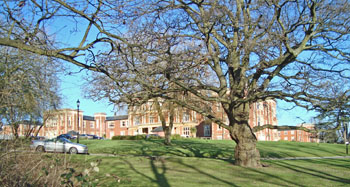
The main Jacobean-style building is now Victoria Court.
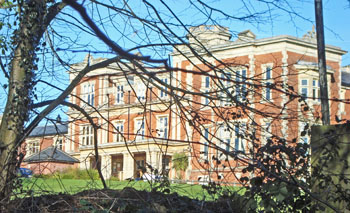
The builder of the original Hospital was Mr John Jay, of London Wall, who also rebuilt the Houses of Parliament following the fire in 1833.
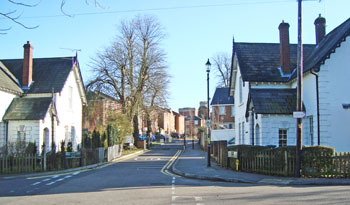
The two lodges on opposite sides of the driveway into the Hospital were Grade II listed in 1998.
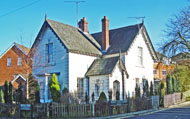
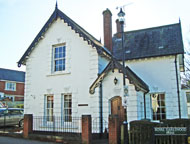
The two matching lodges - East Lodge (left) and the West Lodge (right) - are at the northern entrance to the site on Princes Road. Used as staff accommodation, during the 1970s they became Rehabilitation Units for patients about to be returned to the community. The East Lodge accommodated 3 people and the West Lodge 4.
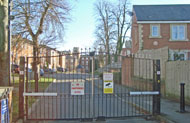
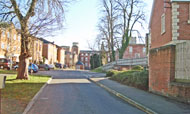
The entrance into Royal Earlswood Park (left) and the housing beyond the gate (right).
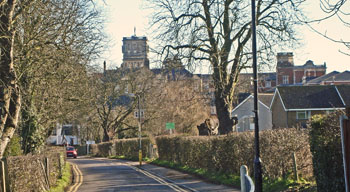
The former Hospital buildings, as seen from Princes Road, Earlswood.
http://jaquo.com
www.guardian.co.uk
www.telegraph.co.uk
(Author unstated) 1868 Earlswood Asylum. British Medical Journal 1 (383), 432.
(Author unstated) 1877 The Earlswood Asylum. British Medical Journal 2 (863), 54.
(Author unstated) 1878 Mortality of imbecile children. British Medical Journal 1 (908), 758.
(Author unstated) 1904 Earlswood Asylum. British Medical Journal 1 (2269), 1502-1503.
(Author unstated) 1904 Earlswood Asylum. British Journal of Nursing, 7th May, 378.
(Author unstated) 1905 The Earlswood Asylum. British Medical Journal 2 (2336), 911.
(Author unstated) 1908 The Earlswood Asylum. British Medical Journal 2 (2498), 1527.
(Author unstated) 1910 Earlswood Asylum, Redhill, Surrey. British Medical Journal 2 (2596), S315.
(Author unstated) 1914 The Royal Earlswood Institution for Mental Defectives. British Medical Journal 2 (2816), 1075-1076.
(Author unstated) 1916 Certified institutions for idiots, imbeciles, and feeble-minded. British Medical Journal 2 (1869), 931.
(Author unstated) 1918 British Medical Journal, 16th Nov, 546.
Chaplin R, Peters S 2003 Executives have taken over the asylum: the fate of 71 psychiatric hospitals. Psychiatric Bulletin 27, 227-229.
Gladstone D 1996 Western Counties Idiot Asylum 1864-1914. In: Digby A, Wright D (eds) From Idiocy to Mental Deficiency: Historic Perspectives on People with Learning Disabilities. Abingdon, Routledge.
Hull CCP, Holman C, Howard H 1904 Earlswood Asylum, British Medical Journal 1 (2269), 1515.
Hunt EA 1903 The Eastern Counties' Asylum for Idiots, Imbeciles and the Feeble-Minded c.f. Some Similiar Institutions Elsewhere with Notes Upon the Question of Tuberculosis. Colchester, Eastern Counties.
Lea A 2005 Royal Earlswood: A History. Redhill, Royal Earlswood Museum Committee.
Wright D 2001 Mental Disability in Victorian England. The Earlswood Asylum 1847-1901. Oxford University Press.
Sakula A 1986 Royal Earlswood Hospital: a historical sketch. Journal of the Royal Society of Medicine 81, 107-108.
http://adc.bmj.com
http://commons.wikimedia.org
http://discovery.nationalarchives.gov.uk
http://en.wikipedia.org (1)
http://en.wikipedia.org (2)
http://hansard.millbanksystems.com
https://commons.wikimedia.com
https://historicengland.org.uk (1)
https://historicengland.org.uk (2)
https://.langdondownmuseum.org.uk
www.aim25.ac.uk
www.alamy.com
www.architectsussex.co.uk
www.britishlistedbuildings.co.uk
www.buildingbetterhealthcare.co.uk
www.countyasylums.co.uk
www.exploringsurreyspast.org.uk (1)
www.exploringsurreyspast.org.uk (2)
www.exploringsurreyspast.org.uk (3)
www.exploringsurreyspast.org.uk (4)
www.exploringsurreyspast.org.uk (5)
www.exploringsurreyspast.org.uk (6)
www.geograph.org.uk (1)
www.geograph.org.uk (2)
www.geograph.org.uk (3)
www.geograph.org.uk (4)
www.heritage-explorer.co.uk (1)
www.heritage-explorer.co.uk (2)
www.imagesofengland.org.uk
www.oldreigate.com
www.pastscape.org.uk
www.redhillandreigatelife.co.uk
www.redwoodworld.co.uk
www.schoolsofnursing.co.uk
www.youtube.com
Return to home page